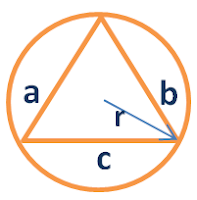Area Formulas
1. Given base and altitude
 |
| Triangle: Given base and height |
Area = 1/2 (b)(h)
2. Given two sides and an Angle
 |
| Triangle Given 3 sides a,b,c |
Area = sqrt (s(s-a)(s-b)(s-c))-----> Heron's Formula
where s= (a+b+c)/2
4. Triangle inscribed in a circle
 |
| r= radius of the circle |
Area = (a b c)/ 4r
5. Given a circle inscribed in a Triangle
 |
| r = radius of the circle |
Area = rs
s = ( a+b+c/) 2
6. Circle escribed by the triangle
 |
| where a is the side tangent to the circle |
Area = r (s-a)
s = ( a+b+c/) 2

































